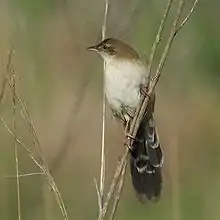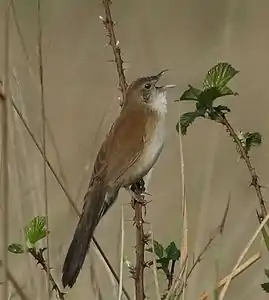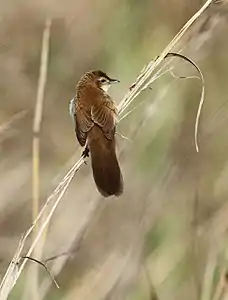Fan-tailed grassbird
The fan-tailed grassbird or broad-tailed warbler (Catriscus brevirostris) is an African species of Old World warbler in the family Locustellidae. The species is closely related to the broad-tailed grassbird of India, and is sometimes treated as the same species,[2] although a 2018 study found that it and the broad-tailed grassbird were not closely related, with the Indian species being a sister of Chaetornis striata.[3]
| Fan-tailed grassbird | |
|---|---|
 | |
| near Pietermaritzburg, Kwa-Zulu Natal, South Africa | |
| Scientific classification | |
| Domain: | Eukaryota |
| Kingdom: | Animalia |
| Phylum: | Chordata |
| Clade: | Dinosauria |
| Class: | Aves |
| Order: | Passeriformes |
| Family: | Locustellidae |
| Genus: | Catriscus Cabanis, 1850 |
| Species: | C. brevirostris |
| Binomial name | |
| Catriscus brevirostris (Sundevall, 1850) | |
| Synonyms | |
|
Catriscus apicalis | |
The species has a discontinuous distribution across Africa, and is found in Angola, Burundi, Cameroon, Republic of the Congo, Democratic Republic of the Congo, Eswatini, Equatorial Guinea, Ethiopia, Gabon, Guinea, Kenya, Malawi, Mozambique, Nigeria, Rwanda, Sierra Leone, South Africa, South Sudan, Tanzania, Uganda, Zambia, and Zimbabwe. It is found in grassy areas dominated by grasses, sedges or shrubs near water (streams, rivers or lakes), from 350–2,150 m (1,150–7,050 ft).[2]
Gallery
References
- BirdLife International (2012). "Schoenicola brevirostris". IUCN Red List of Threatened Species. 2012. Retrieved 26 November 2013.
- Madge, S. (2017). Fan-tailed Grassbird (Schoenicola brevirostris). In: del HoyAltouo, J., Elliott, A., Sargatal, J., Christie, D.A. & de Juana, E. (eds.). Handbook of the Birds of the World Alive. Lynx Edicions, Barcelona. (retrieved from http://www.hbw.com/node/58725 on 17 March 2017).
- Alström, Per; Cibois, Alice; Irestedt, Martin; Zuccon, Dario; Gelang, Magnus; Fjeldså, Jon; Andersen, Michael J; Moyle, Robert G; Pasquet, Eric; Olsson, Urban (2018). "Comprehensive molecular phylogeny of the grassbirds and allies (Locustellidae) reveals extensive non-monophyly of traditional genera, and a proposal for a new classification". Molecular Phylogenetics and Evolution. 127: 367–375. doi:10.1016/j.ympev.2018.03.029. PMID 29625229. S2CID 4645834.

_(14566057207).jpg.webp)

